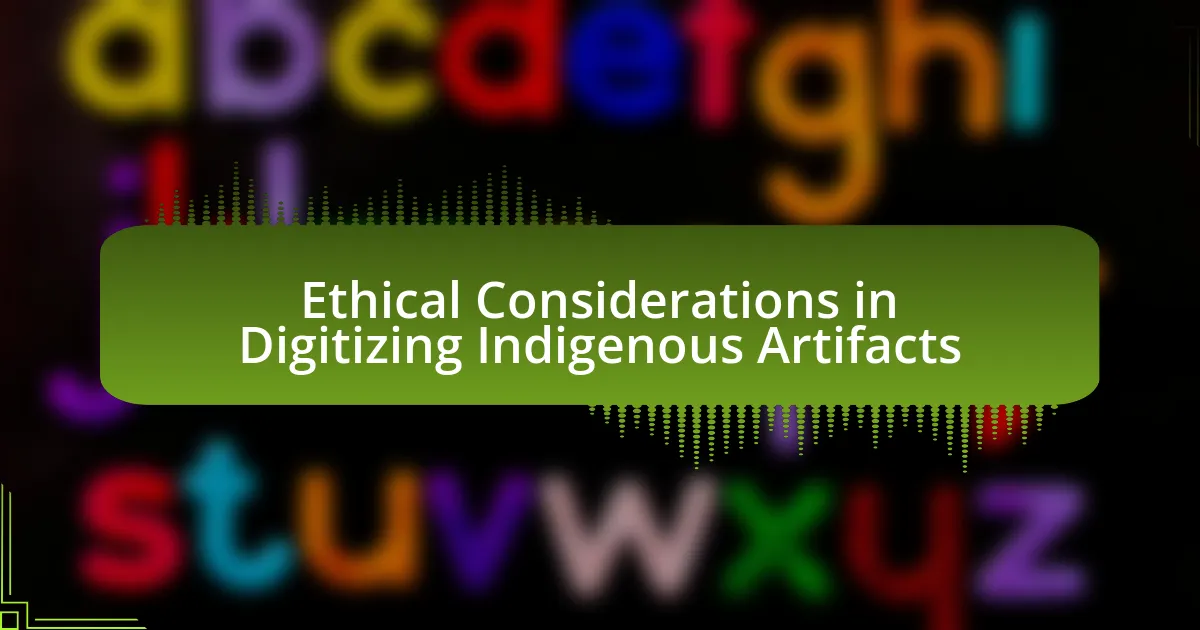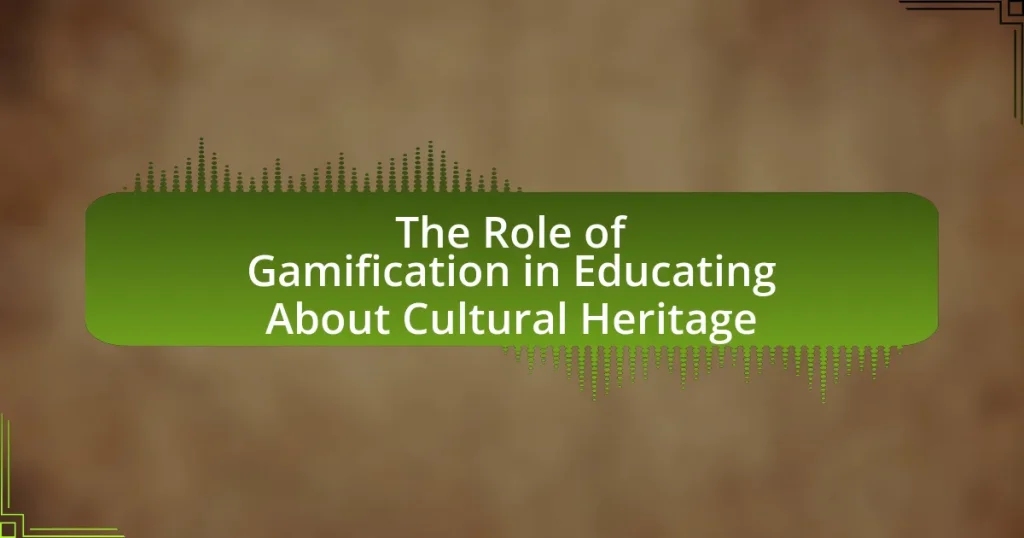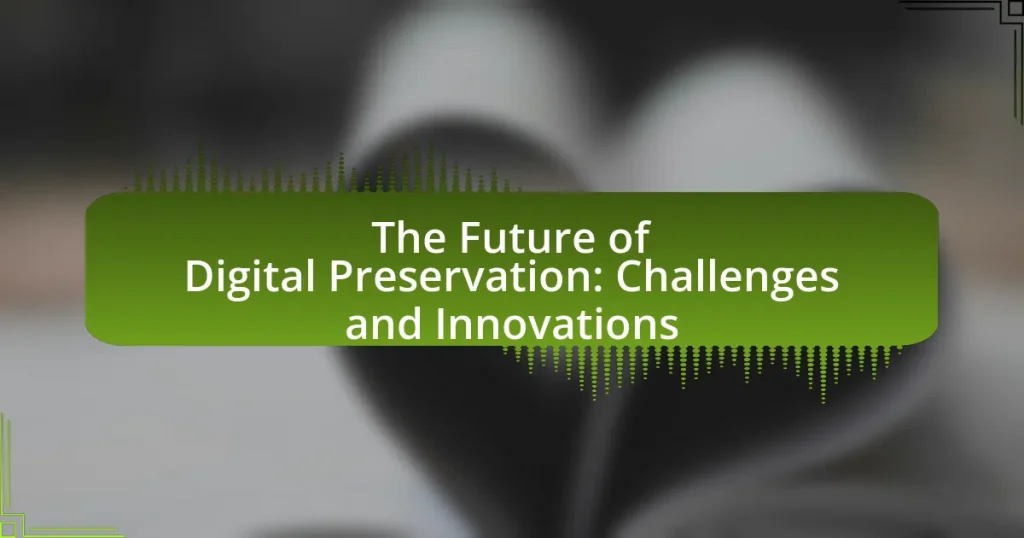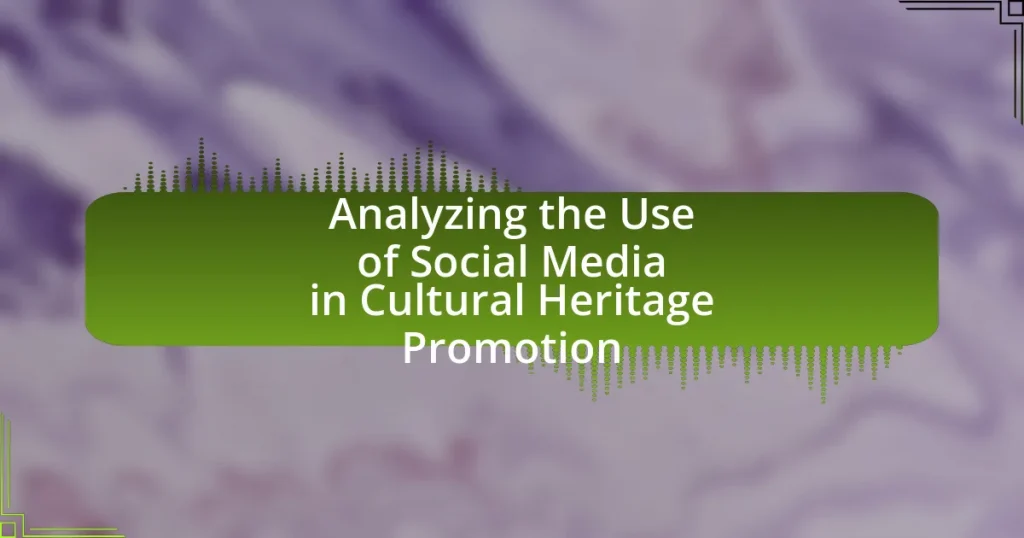The article focuses on the ethical considerations involved in digitizing Indigenous artifacts, emphasizing the importance of obtaining consent from Indigenous communities, respecting cultural significance, and preventing misrepresentation. It discusses the historical context of colonialism that influences current power dynamics and highlights the risks associated with unauthorized access and cultural appropriation. The article outlines best practices for ethical digitization, including community engagement, informed consent, and adherence to established frameworks that prioritize Indigenous rights and cultural heritage. Additionally, it provides resources and guidelines for practitioners to ensure that digitization efforts are respectful and culturally sensitive.
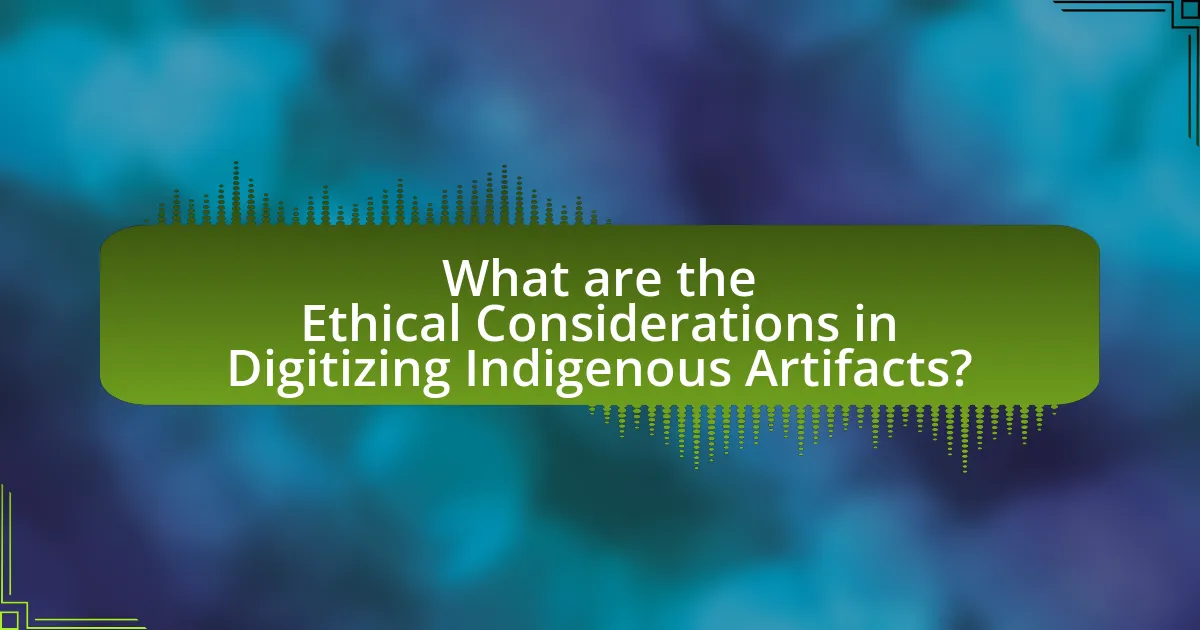
What are the Ethical Considerations in Digitizing Indigenous Artifacts?
Ethical considerations in digitizing Indigenous artifacts include the need for consent from Indigenous communities, respect for cultural significance, and the potential for misrepresentation. Consent is crucial, as many Indigenous groups seek to control how their cultural heritage is shared and represented. Respecting cultural significance involves understanding that artifacts may hold spiritual or communal value, which can be diminished through digitization. Misrepresentation can occur if artifacts are taken out of context or if the digitization process does not accurately reflect their cultural meanings. These considerations are supported by frameworks such as the United Nations Declaration on the Rights of Indigenous Peoples, which emphasizes the rights of Indigenous peoples to maintain and protect their cultural heritage.
Why is it important to consider ethics in the digitization of Indigenous artifacts?
Considering ethics in the digitization of Indigenous artifacts is crucial to ensure respect for cultural heritage and the rights of Indigenous communities. Ethical considerations help prevent the exploitation and misrepresentation of Indigenous knowledge and traditions, which can occur when artifacts are digitized without proper consent or collaboration with the originating communities. For instance, the American Indian Museum emphasizes the importance of involving Indigenous peoples in the decision-making process regarding their cultural materials, as this fosters trust and acknowledges their ownership and stewardship of these artifacts. Additionally, ethical digitization practices can promote the preservation of cultural identity and support the educational and cultural needs of Indigenous peoples, ensuring that their narratives are accurately represented in digital formats.
What historical context influences the ethical considerations?
The historical context influencing ethical considerations in digitizing Indigenous artifacts includes the legacy of colonialism, which often involved the appropriation and misrepresentation of Indigenous cultures. This context is critical as it shapes the ongoing power dynamics between Indigenous communities and institutions that hold their cultural heritage. For instance, the 19th-century practices of collecting artifacts without consent have led to contemporary calls for repatriation and ethical stewardship, emphasizing the need for collaboration with Indigenous peoples in the digitization process. Additionally, historical treaties and legal frameworks, such as the United Nations Declaration on the Rights of Indigenous Peoples, further inform ethical guidelines by advocating for the rights of Indigenous communities to control their cultural expressions and heritage.
How do power dynamics affect the digitization process?
Power dynamics significantly influence the digitization process by determining who controls the narrative and access to indigenous artifacts. In contexts where power imbalances exist, such as between indigenous communities and external institutions, the latter may dominate the digitization efforts, often prioritizing their interests over those of the communities. This can lead to misrepresentation or exploitation of cultural heritage, as seen in cases where museums digitize artifacts without proper consent or collaboration with indigenous peoples. Research indicates that when indigenous communities are actively involved in the digitization process, it fosters a more equitable representation and respect for cultural significance, as highlighted in the work of authors like K. A. B. McCarthy and R. A. S. Smith in “Indigenous Knowledge and Digital Media” (Journal of Cultural Heritage, 2021).
What are the potential risks associated with digitizing Indigenous artifacts?
The potential risks associated with digitizing Indigenous artifacts include cultural appropriation, loss of context, and unauthorized access. Cultural appropriation occurs when digital representations are used without the consent of Indigenous communities, leading to exploitation and misrepresentation of their heritage. Loss of context can happen when artifacts are removed from their cultural and historical backgrounds, diminishing their significance and meaning. Unauthorized access poses a risk as digital copies can be easily disseminated, potentially leading to the commodification of sacred items or knowledge that should remain within the community. These risks highlight the need for ethical considerations and collaboration with Indigenous peoples in the digitization process.
How can misrepresentation occur during digitization?
Misrepresentation can occur during digitization when the cultural context, significance, or details of indigenous artifacts are inadequately captured or altered. This can happen due to a lack of understanding of the artifact’s cultural background by the digitizers, leading to oversimplification or misinterpretation of its meaning. For instance, if an artifact is digitized without consulting the indigenous community it originates from, critical elements such as traditional uses, stories, or spiritual significance may be omitted, resulting in a distorted representation. Studies have shown that digitization efforts that do not involve community input often lead to inaccuracies, as evidenced by cases where indigenous artifacts were misrepresented in museum databases, failing to reflect their true cultural importance.
What are the implications of unauthorized access to digital artifacts?
Unauthorized access to digital artifacts can lead to significant ethical violations, including the misrepresentation and exploitation of cultural heritage. Such access undermines the rights of Indigenous communities, as it often results in the unauthorized use of their cultural expressions without consent or proper attribution. For instance, the unauthorized reproduction of Indigenous art can dilute its cultural significance and lead to commodification, which is detrimental to the community’s identity and heritage. Furthermore, unauthorized access can facilitate the spread of misinformation, as digital artifacts may be taken out of context or misinterpreted, further harming the cultural narrative. These implications highlight the necessity for ethical guidelines and respect for the ownership and cultural significance of digital artifacts.
How can cultural sensitivity be maintained in the digitization process?
Cultural sensitivity can be maintained in the digitization process by actively involving Indigenous communities in decision-making and ensuring their perspectives are respected throughout the project. Engaging these communities allows for the identification of culturally significant elements and the establishment of guidelines that honor their traditions and values. For instance, the American Indian Library Association emphasizes the importance of collaboration with Indigenous peoples to ensure that digitization efforts reflect their cultural narratives accurately and respectfully. This approach not only fosters trust but also aligns with ethical standards that prioritize the rights and voices of Indigenous communities in the preservation of their cultural heritage.
What role do Indigenous communities play in the digitization process?
Indigenous communities play a crucial role in the digitization process by ensuring that their cultural heritage is accurately represented and ethically managed. Their involvement is essential for safeguarding traditional knowledge and practices, as they provide context and meaning to the artifacts being digitized. For instance, Indigenous perspectives can guide the selection of materials for digitization, ensuring that culturally sensitive items are handled appropriately. Furthermore, studies have shown that when Indigenous communities are actively engaged in digitization projects, the outcomes are more respectful and aligned with their values, leading to better preservation of their cultural identity.
How can consent be effectively obtained from Indigenous groups?
Consent can be effectively obtained from Indigenous groups through transparent communication, respect for cultural protocols, and inclusive decision-making processes. Engaging with Indigenous communities requires establishing trust and ensuring that their voices are heard and valued in discussions about the digitization of their artifacts. This can involve conducting consultations that are culturally appropriate and allowing for adequate time for reflection and response.
Furthermore, it is essential to recognize the historical context of colonization and its impact on Indigenous rights, which underscores the importance of obtaining informed consent. For instance, the United Nations Declaration on the Rights of Indigenous Peoples emphasizes the necessity of obtaining free, prior, and informed consent before undertaking projects that affect Indigenous lands, resources, or cultural heritage. By adhering to these principles, organizations can foster a collaborative environment that honors Indigenous knowledge and rights.
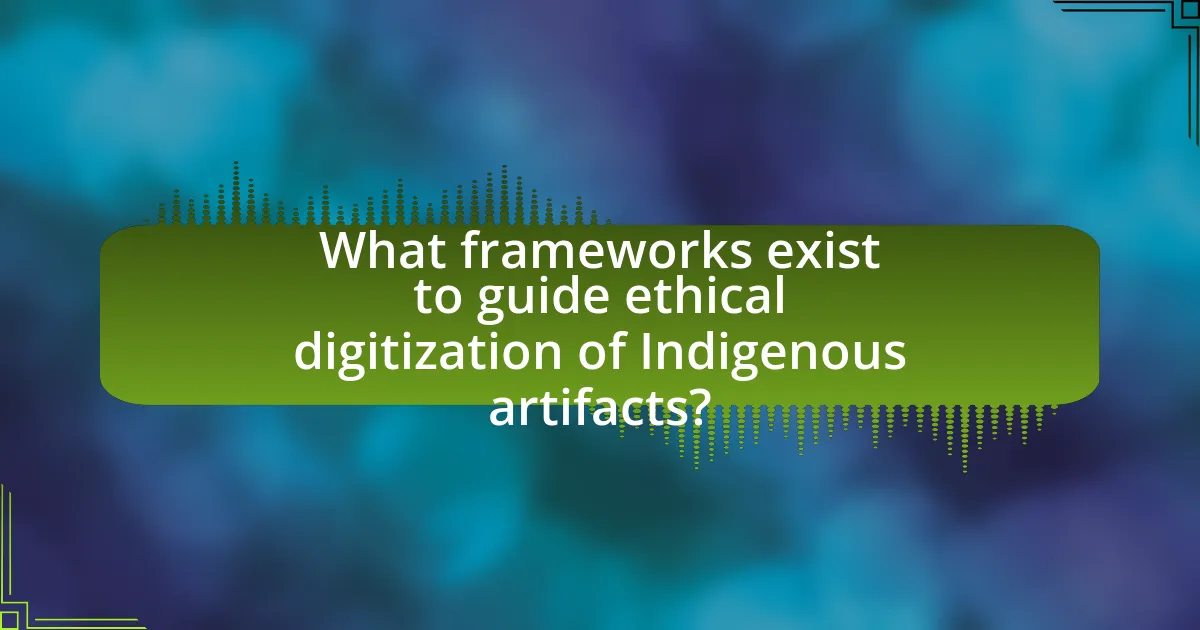
What frameworks exist to guide ethical digitization of Indigenous artifacts?
Frameworks that guide ethical digitization of Indigenous artifacts include the “Protocol for Native American Archival Materials,” developed by the Society of American Archivists, which emphasizes respect for Indigenous cultural heritage and the importance of community involvement. Another significant framework is the “Digital Cultural Heritage Framework” from the International Council on Archives, which advocates for the ethical representation and accessibility of Indigenous materials. Additionally, the “First Nations Principles of OCAP” (Ownership, Control, Access, and Possession) provides a guideline for Indigenous communities to maintain control over their cultural data. These frameworks collectively stress the necessity of collaboration with Indigenous communities, ensuring their voices are integral to the digitization process.
What are the key principles of ethical digitization?
The key principles of ethical digitization include respect for cultural heritage, informed consent, and equitable access. Respect for cultural heritage ensures that the significance and context of indigenous artifacts are preserved during the digitization process. Informed consent involves obtaining permission from the communities or individuals associated with the artifacts before digitization, acknowledging their rights and perspectives. Equitable access promotes the idea that digitized materials should be accessible to the communities from which they originate, allowing them to engage with their cultural heritage. These principles are essential for maintaining integrity and fostering trust in the digitization of indigenous artifacts.
How do these principles align with Indigenous rights and sovereignty?
The principles of ethical considerations in digitizing Indigenous artifacts align closely with Indigenous rights and sovereignty by emphasizing respect for cultural heritage and the autonomy of Indigenous communities. These principles advocate for the involvement of Indigenous peoples in decision-making processes regarding the digitization and dissemination of their cultural artifacts, thereby recognizing their rights to control their cultural narratives. For instance, the United Nations Declaration on the Rights of Indigenous Peoples (UNDRIP) asserts that Indigenous peoples have the right to maintain and control their cultural heritage, which supports the ethical imperative to seek consent and collaboration in digitization efforts. This alignment ensures that Indigenous communities retain sovereignty over their cultural expressions and that their rights are upheld in the digital realm.
What guidelines have been established by cultural institutions?
Cultural institutions have established guidelines focused on ethical considerations in digitizing Indigenous artifacts, emphasizing respect for cultural heritage and community involvement. These guidelines typically include obtaining informed consent from Indigenous communities before digitization, ensuring that the cultural significance of artifacts is preserved, and providing equitable access to digital resources. For instance, the American Alliance of Museums outlines the importance of collaboration with Indigenous peoples to ensure that their perspectives and rights are honored in the digitization process. Additionally, the Australian Institute for Aboriginal and Torres Strait Islander Studies emphasizes the need for cultural protocols that guide the representation and sharing of Indigenous knowledge in digital formats.
How can technology be leveraged to support ethical practices?
Technology can be leveraged to support ethical practices by ensuring transparency and accountability in the digitization of Indigenous artifacts. Digital platforms can provide detailed provenance information, allowing stakeholders to trace the origins and ownership history of artifacts, which is crucial for respecting Indigenous rights. For instance, using blockchain technology can create immutable records of artifact ownership and usage rights, thereby preventing unauthorized exploitation. Additionally, virtual reality and augmented reality can facilitate immersive experiences that educate users about the cultural significance of these artifacts, promoting respect and understanding. Research indicates that ethical frameworks in digital heritage projects enhance community engagement and foster collaborative decision-making, ensuring that Indigenous voices are prioritized in the digitization process.
What tools are available for ensuring ethical digitization?
Tools available for ensuring ethical digitization include ethical guidelines, consent management systems, and culturally sensitive metadata frameworks. Ethical guidelines, such as those provided by the American Alliance of Museums, outline best practices for respecting the rights and cultural significance of Indigenous artifacts. Consent management systems facilitate obtaining and documenting permission from Indigenous communities before digitization occurs, ensuring that their voices are included in the process. Culturally sensitive metadata frameworks help in accurately representing the context and significance of artifacts, which is crucial for maintaining their integrity and meaning. These tools collectively support the ethical digitization of Indigenous artifacts by prioritizing respect, consent, and cultural context.
How can digital platforms promote Indigenous narratives?
Digital platforms can promote Indigenous narratives by providing a space for Indigenous voices to share their stories, culture, and perspectives directly. These platforms enable Indigenous communities to control the representation of their narratives, ensuring authenticity and respect for their traditions. For instance, initiatives like the Indigenous Digital Archive allow for the preservation and dissemination of Indigenous knowledge and history, fostering greater understanding and appreciation among wider audiences. Furthermore, social media campaigns and online storytelling projects have successfully engaged younger generations, amplifying Indigenous perspectives and challenging stereotypes.
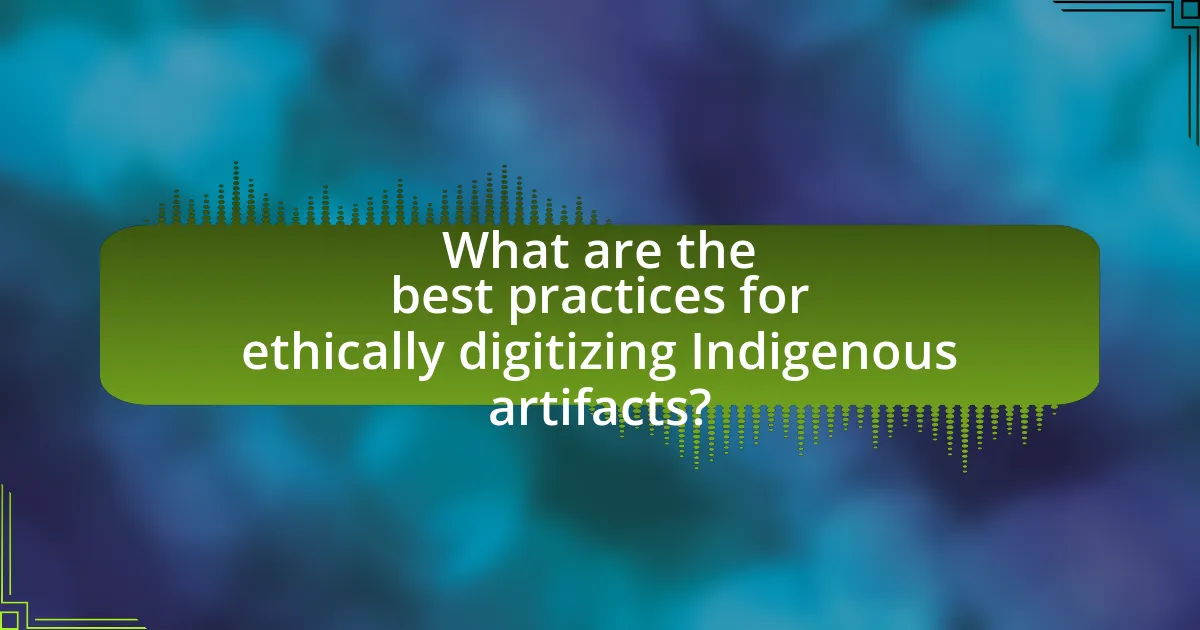
What are the best practices for ethically digitizing Indigenous artifacts?
The best practices for ethically digitizing Indigenous artifacts include obtaining informed consent from Indigenous communities, ensuring cultural sensitivity, and providing equitable access to the digitized materials. Informed consent involves engaging with the community to understand their perspectives and wishes regarding the digitization process. Cultural sensitivity requires recognizing the significance of artifacts and respecting traditional knowledge and practices associated with them. Equitable access ensures that Indigenous communities can benefit from the digitized materials, fostering collaboration and shared stewardship. These practices align with ethical guidelines established by organizations such as the American Alliance of Museums, which emphasizes the importance of community involvement and respect for cultural heritage.
What steps should be taken to ensure ethical digitization?
To ensure ethical digitization of Indigenous artifacts, institutions must prioritize community engagement, informed consent, and cultural sensitivity. Engaging with Indigenous communities allows for the incorporation of their perspectives and values in the digitization process. Informed consent ensures that communities are fully aware of how their cultural materials will be used and shared, which is crucial for respecting their rights. Cultural sensitivity involves understanding the significance of artifacts within their cultural context, which can guide decisions on what to digitize and how to present it. These steps are supported by frameworks such as the United Nations Declaration on the Rights of Indigenous Peoples, which emphasizes the importance of Indigenous peoples’ rights to their cultural heritage.
How can collaboration with Indigenous communities enhance the process?
Collaboration with Indigenous communities can enhance the process of digitizing Indigenous artifacts by ensuring cultural sensitivity and accuracy in representation. Engaging Indigenous voices allows for the incorporation of traditional knowledge and perspectives, which can lead to more authentic and respectful digital representations. For instance, the Australian Institute of Aboriginal and Torres Strait Islander Studies emphasizes that involving Indigenous communities in the digitization process helps preserve cultural heritage and fosters trust between institutions and communities. This collaborative approach not only enriches the content but also aligns with ethical standards that prioritize the rights and interests of Indigenous peoples in the management of their cultural heritage.
What measures can be implemented to protect cultural heritage?
To protect cultural heritage, measures such as legal frameworks, community engagement, and digital preservation can be implemented. Legal frameworks, including international treaties like the UNESCO Convention for the Safeguarding of the Intangible Cultural Heritage, provide guidelines for protecting cultural expressions and practices. Community engagement ensures that indigenous voices are included in decision-making processes, fostering respect and ownership over cultural artifacts. Digital preservation techniques, such as high-resolution imaging and 3D modeling, allow for the documentation and sharing of artifacts while minimizing physical handling, thus reducing the risk of damage. These measures collectively contribute to the safeguarding of cultural heritage for future generations.
What resources are available for further learning about ethical digitization?
Resources for further learning about ethical digitization include academic journals, online courses, and guidelines from reputable organizations. For instance, the “Journal of Digital Humanities” publishes articles on ethical practices in digitization. Additionally, the “Digital Preservation Coalition” offers resources and best practices for ethical digitization. Online platforms like Coursera and edX provide courses on digital ethics, which cover the implications of digitizing cultural artifacts. These resources collectively enhance understanding of the ethical considerations involved in digitizing indigenous artifacts.
Where can practitioners find case studies on ethical digitization?
Practitioners can find case studies on ethical digitization in academic journals, institutional repositories, and specialized databases focused on digital humanities and indigenous studies. For instance, the Journal of Digital Humanities and the International Journal of Heritage Studies often publish relevant case studies. Additionally, organizations like the American Indian Library Association provide resources and case studies on ethical practices in digitizing indigenous artifacts. These sources are credible as they are peer-reviewed and widely recognized in the field of digital ethics and cultural preservation.
What organizations provide support for ethical practices in digitization?
Organizations that provide support for ethical practices in digitization include the American Alliance of Museums, the International Council of Museums, and the Digital Library Federation. The American Alliance of Museums offers guidelines and resources for museums to ethically digitize collections, emphasizing respect for cultural heritage. The International Council of Museums promotes ethical standards in the preservation and digitization of cultural artifacts, ensuring that indigenous communities are consulted and involved in the process. The Digital Library Federation focuses on best practices for digital stewardship, advocating for transparency and ethical considerations in digitization projects. These organizations collectively reinforce the importance of ethical practices in the digitization of indigenous artifacts.
What practical tips can be applied to ensure ethical digitization of Indigenous artifacts?
To ensure ethical digitization of Indigenous artifacts, institutions should prioritize collaboration with Indigenous communities throughout the process. Engaging these communities fosters respect and ensures that the cultural significance of the artifacts is preserved. For instance, institutions can establish advisory boards comprising Indigenous representatives to guide the digitization efforts, ensuring that the community’s perspectives and values are integrated. Additionally, obtaining informed consent from Indigenous groups before digitization is crucial, as it respects their rights and ownership over cultural heritage. Research indicates that ethical frameworks, such as those outlined by the American Indian Library Association, emphasize the importance of community involvement and consent in the management of Indigenous cultural materials.
